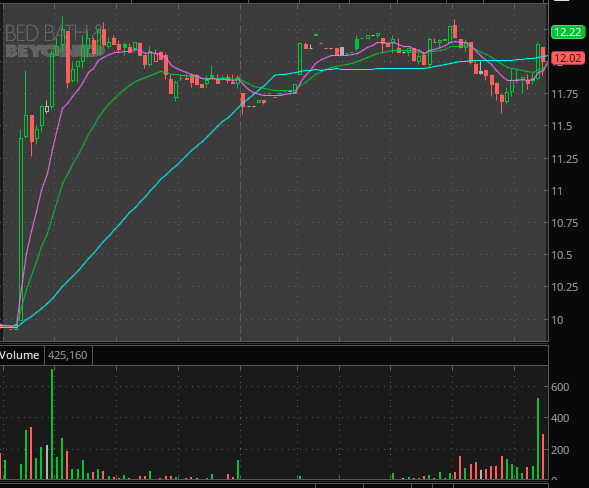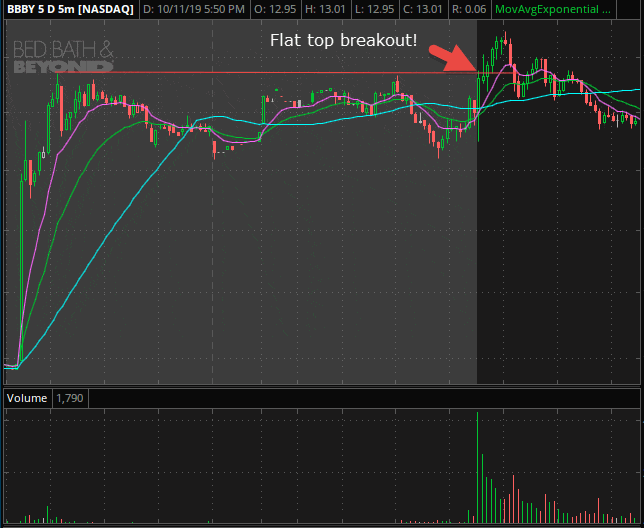Flat Top Breakouts – the Bigger Ones
The flat top breakout is a bullish chart pattern that both swing traders and day traders look for when scouring the market for good trading opportunities.
Its very similar to the flat base pattern but is normally discussed in the context of day trading.
The swing trading patterns offer much more upside potential and are much more exciting to us on top growth stocks, all else being equal, but more about that in a moment.
The first thing I want to do is show you a flat top pattern on a shorter time-frame so you know what it is and the typical entry/exit strategies.
How to Identify Breakout Stocks by Looking for Flat Top Patterns
Some traders trade with the intention of owning a stock for just a few minutes or hours. This is referred to as day trading versus swing trading where you hold the stock at least 1 day over night. (See day trading vs swing trading to learn more.)
Lets start by looking at a flat top pattern that just came up on our radar yesterday morning.

The grey background on the chart signifies pre-market and after hours trading activity. This is a chart snapshot from the Thinkorswim trading platform.
BBBY (Bed Bath & Beyond) came out the prior evening with news that they were hiring a new CEO that has a great track record in an area where they want to improve – merchandising.
A new CEO can be a big game changer for a company and stock price. In this case, BBBY jumped more than 15% after the news and began to form a flat top consolidation after hours and before the market opened the next day.
The flat top pattern is a narrow consolidation pattern that you can see on the chart above. The price is in a long consolidation between about $11.60 and $12.35. Sometimes, the pattern begins to form an ascending triangle where it makes higher lows and finds resistance at around the same price point.
We prefer the ones that are just rectangular shaped or that begin to make higher lows late in the consolidation near the flat top breakout.
The Flat Top Breakout
After a long consolidation, and preferably at least 3 tests of the top of the flat top consolidation, the price will sometimes break out by moving above the top of the flat top pattern. This is the flat top breakout.
Here is the breakout in the above example. Again on a 5 minute chart (each candle on the chart represents the low price, high price, open and closing price of the next five minutes of trading)

What is happening is that the buyers are beginning to overwhelm the sellers in the prior trading range – the flat top pattern. Because we have a fresh catalyst, its more likely that more buyers will come in over time after analyzing the new news.
Also, on higher priced stocks especially, fund managers will be scaling into a new position or adding to an existing position. Because of their immense buying power, fund managers will scale in over time instead of buying all at once.
This increases the chance of a breakout. Unfortunately, fund managers generally cannot buy stocks under $5 because of their poor historical performance.
In this case, BBBY broke out to the upside and surged over 3% higher very quickly which is typical out of this day trading pattern on good but not the best opportunities. The best opportunities that meet the requirements in the earnings eruptions strategy (most flat top breakouts don’t) tend to move much further.
Entry/Exit Signals
On the best opportunities and catalysts, I’ll often start a position ahead of the breakout. In most cases, I will wait for the actual breakout with enough volume. Level 2 data can be helpful for day trading but for the swing trading setups they can be of little use on the very best opportunities.
So normally the entry point is slightly above the high in the flat top pattern. The narrow pattern is nice because it provides support if the price briefly goes back into the prior range.
The stop we often use is slightly below the low in the flat top pattern. For day traders, this is often too wide of a stop to be profitable.
The profit target we use will vary depending on the overhead resistance levels. In this case, BBBY had the 200 day moving average a few percent above the breakout point.
This could have been a great target when day trading. After the price reached the 200 day moving average it began to pull back and go below the entry point.
How to Identify Breakout Stocks When Swing Trading
The flat top breakout is more significant on longer time-frames. What I mean by that is that the profit potential is a much greater when you find the flat top pattern on a longer-term daily chart.
So instead of a 5 minute candlestick chart, a 1 year daily candlestick chart. The candles look the same, and so does the pattern, but the upside is much greater in general.
In fact, I find the best day trading opportunities are those near a great entry point on a longer time-frame. A flat top breakout intraday near the entry point of a flat top pattern on a longer-term daily chart is ideal.
Here is a flat top breakout pattern on ROKU which occurred early this year. This pattern also met the requirements for our bull flag pattern or high tight flag. The most bullish pattern we trade.

We notified clients of ROKU along with TTD (in a different bullish pattern) in the alert service just ahead of the breakouts in late February.
How We Identify the Best Flat Top Breakouts
ROKU developed a strong uptrend before the flat top breakout which is a key characteristic we look for leading into the flat top chart pattern.
We also find that the win rate drops on stocks under $20 and especially under $10. Stocks over $20 tend to be less risky as well.
If the stock was a pump and dump penny stock (under $5) within the past few months, we tend to avoid it as they have a lower win rate, carry more risk and are more likely to turn over without warning.
This was a shorter pattern in duration in that the narrow consolidation (flat top) only lasted a few days and occurred after the prior flat top breakout. Generally, you want a longer consolidation except for the most extreme uptrends such as this high tight flag pattern.
After breaking out of the flat top early this year, ROKU soared over 300% higher within several months. You see that kind of move a lot more often out of these extreme bull flag patterns over $10. Weaker flag patterns – not so much.
If a stock can make an extreme price move and hold those levels in a narrow consolidation long enough, the chances are better that it will make a strong secondary move if it breaks out with a lot of volume.
The larger the pattern, the bigger the move if conditions are right at the breakout point. Usually, the fundamental and technical conditions are not good enough for us and nowhere near as good as they were for ROKU on multiple breakouts this year.
Flat Top Breakouts and Q3 Earnings Season
We just caught a flat top breakout this morning on FAST. Its not a top growth stock like ROKU and the many others we featured to clients this year before big moves, but it was a nice base hit and easy 4% profit within an hour.
It was also a very clean breakout which is a good sign for the remainder of Q3 earnings season. By clean breakout we mean that the price did not pull back below the entry point hardly at all after the breakout.
Because this pattern is working very well ahead of Q3 earnings season, we expect some big home run trades on top growth stocks in the weeks ahead. Stay tuned. Some of the best setups like ROKU soar 20% to 50% within days or weeks after the breakout.
If you have done the extensive back-testing and research to know which ones have a high likelihood of success, its a very exciting strategy. If not, don’t expect to do well early on as with other trading strategies you are starting to learn.
You can start to develop your own skill at trading flat top breakouts on a simulator without risking real money. Unlike other business ventures, simulators now offer you the opportunity to test and develop your trading strategy and skills without risking a dime.
If you want to save yourself months or years of work in developing your own strategy, you can check out our favorites we have developed and tested extensively over the past few years.
An Example of a Good Flat Top Breakout on Earnings and One We Avoid
Top Opportunities We are Eyeing for Our Own Accounts







